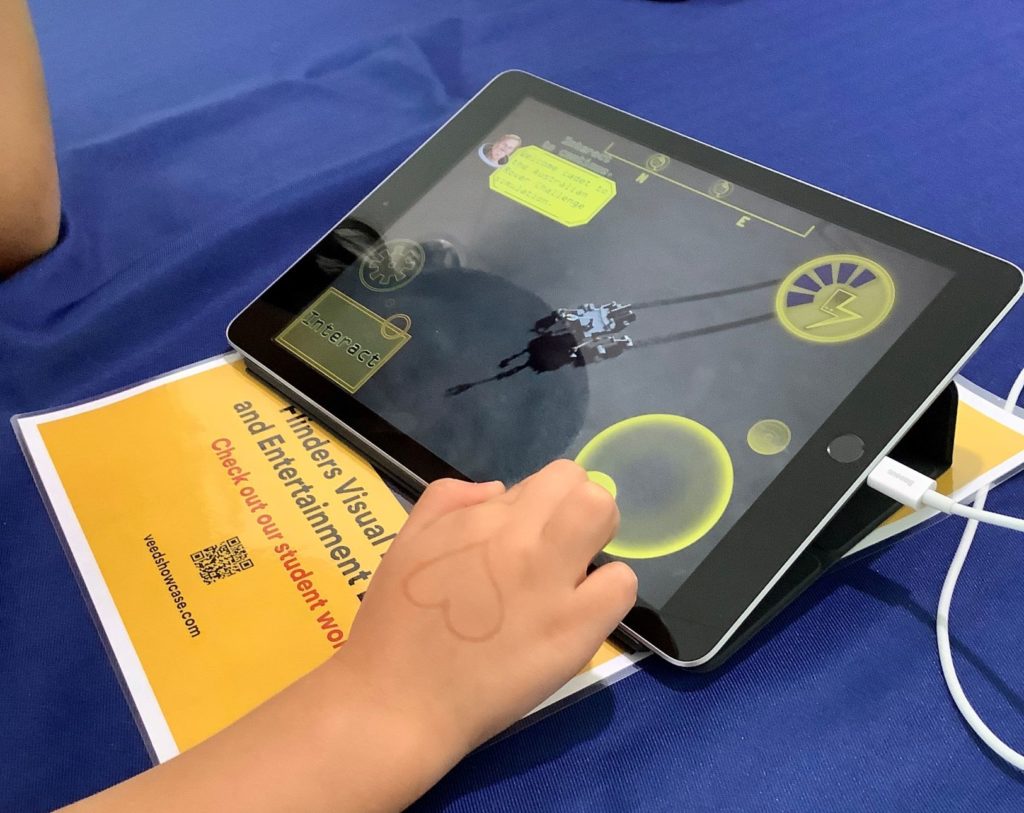
Last month the team from Flinders’ motion capture and virtual production space, The Void, attended the 2022 Australian Rover Challenge, a national competition hosted by the Andy Thomas Centre for Space Resources (ATCSR) at the University of Adelaide.
Robotics students from universities around the country brought their prototype Lunar and Mars rovers to the event. An annual competition, the teams compete in a series of tests to showcase the productivity and technical achievements of the students and see which rover might even be ready for the big stage – the international University Rover Challenge in Utah, United States.
Developing the rover video game
Flinders’ The Void, in partnership with local industry entity Mini Mammoth Games, developed a genuine video game simulation of the Australian Rover Challenge. With a 5-week deadline to design, develop and demonstrate a gamified simulation of the challenge on PC and iPad, Visual Effects and Entertainment Design (VEED) students and lecturers, Void staff and Mini Mammoth Games had to work against the clock to make a live date of 24 March. Challenge accepted!
The students from the VEED topic Digital Games (VEED3005) got straight down to business. Lecturer Shane Bevin tells us more, “Students in VEED3005 create assets suitable for inclusion in a variety of interactive outcomes. This project saw students creating assets within a commercial pipeline – it gave them a chance to have a real-world outcome with real-world constraints. The games industry is driven by collaboration and teamwork and this has been a valuable chance for our students to work with a game company, on a project that required high-quality outcomes within a tight deadline.”
VEED student Daniela Naumovski elaborates, “I was involved in the project through the 2D category and my focus was the UI assets with another student. The benefits that rewarded me personally were gaining new skills in UI design as well as learning how to professionally communicate and work in a team. Working on a project like this has been an amazing experience due to the overwhelmingly positive support by both the team and peers. It means a lot to me as it has helped me step outside my boundaries and gain the confidence to complete professional work under pressure. I highly recommend to anyone to work on projects like this!”
Every visual asset in the game was based on scans and CAD models provided by the Space Centre. It is fun and authentic. The result was far beyond everyone’s expectations. The fully playable demo, running on Windows PC or iPad, allows players to choose one of two playable rovers, one of three simulated gravities (Earth, Mars or Moon), and complete a mission on a simulated Lunar Base!

Showcasing the rover game
Demonstrated during the launch event to a VIP crowd, then at the challenge event from 25-27 March, the Rover Challenge Game Demo was a huge success. Representatives of the Space Centre, members of the Rover teams and families attending the event all lined up to play the game and talk to Void and Mini Mammoth staff. Feedback was overwhelmingly positive. Once again, our VEED students and knowledgeable Void staff have participated in an industry collaboration that seemed impossible at the outset.
Shane adds, “I know that the students were very happy with the chance to see the game played by a huge variety of players, from happy kids driving the virtual moon rover around in the most playful way, through to adults and experts with a more critical eye. This has been a valuable outcome in many ways.”
Daniela confirms, “I loved every aspect of the project, but my personal highlight would be the achievement of putting out some professional work for the public to view and experience. It was rewarding seeing people react and most importantly, like the work we produced.”
The Void’s Drama and Audio Visual Technician Cameron Mackness highlights, “This project was a fantastic opportunity to show how the Void functions as a conduit for the connection of technology and creativity. One of the major focuses of our research in the Void is how to integrate emerging technologies with artists. In this case, we were able to use Space research technology and marry it to game development.”

What does the future hold?
“Video and computer games have been at the cutting edge of developments in interactive narrative, immersive experience, virtuality, and represent a sizeable sector within the media industries”, Shane explains.
All stakeholders at the event from ATCSR, industry and local government are committed to a pathway to funding an educational game that will be released on PC and Apple/Android mobile tablets. Everyone could see the potential to use the game as a STEM education tool that allows primary school students to simulate the basics of rover design and test them in a simulated extra-terrestrial colony.
The Void and Mini Mammoth will be working with ATSCR and various stakeholders locally and in the National Space program to map out the proposal. Flinders is confident our first collaboration with ATCSR will not be the last.
Co-authored by Dan Thorsland, The Void Manager

